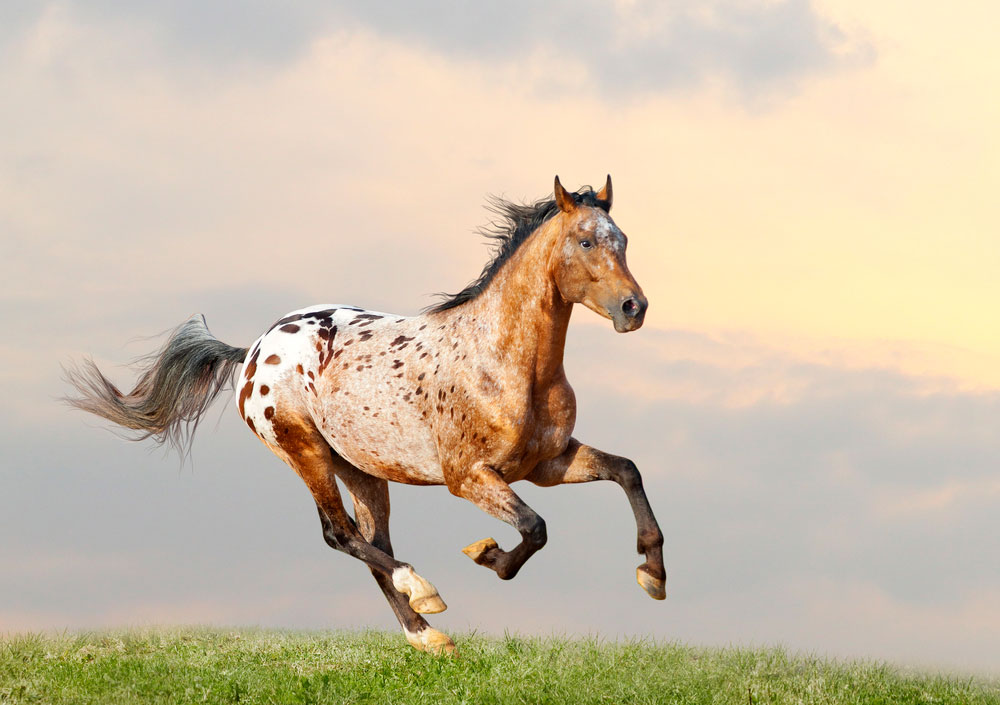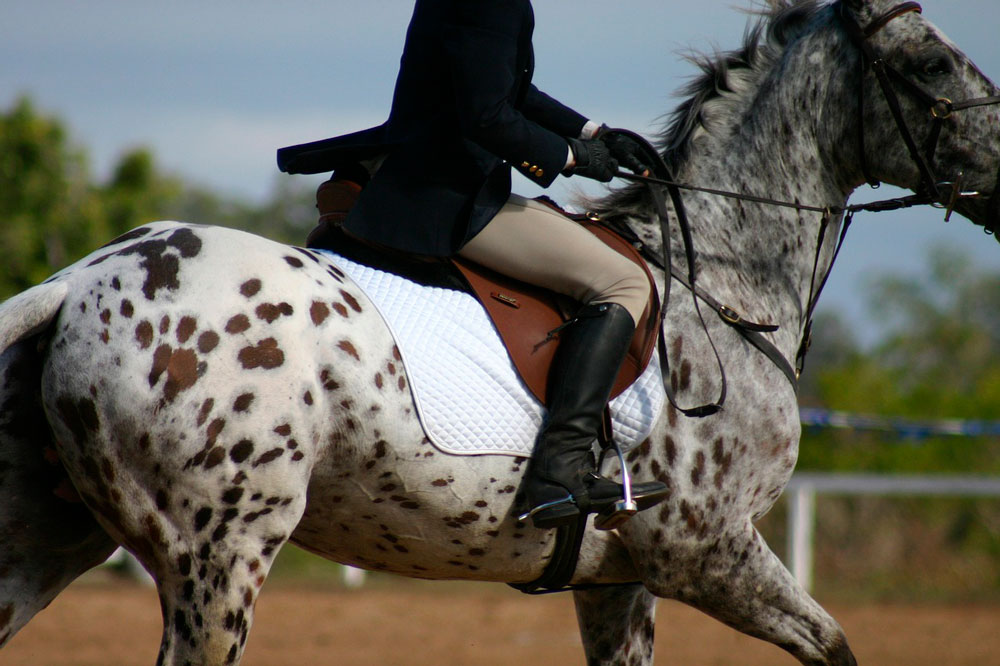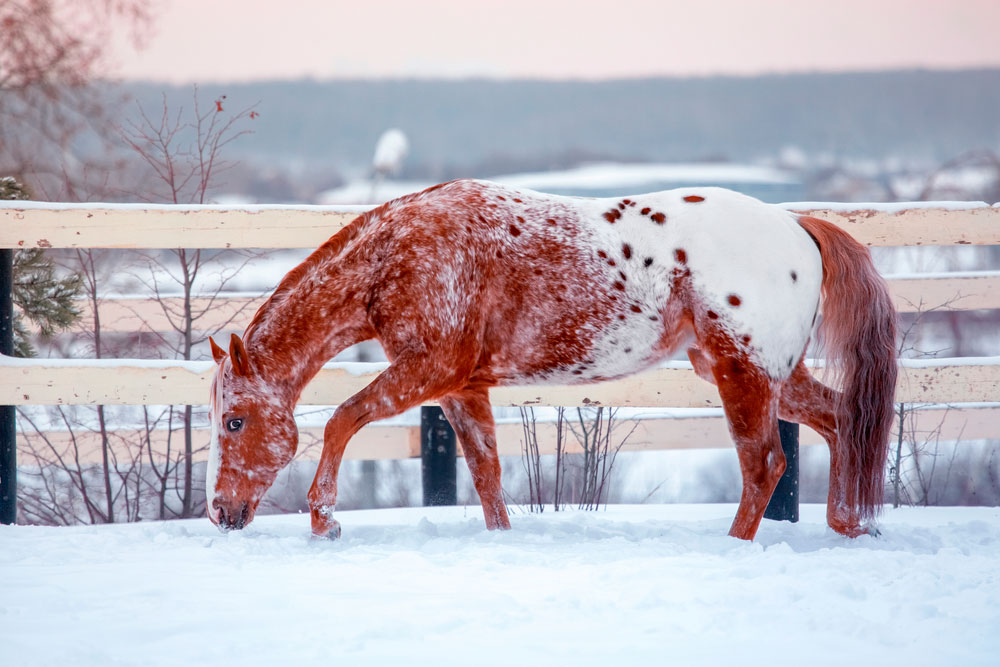
With its unique spotted coat and remarkable background, the Appaloosa breed is one of the most recognizable in equestrian circles. Appaloosas are celebrated for their proficiency in both pleasure riding and horse shows. They are perfect for riders of all levels due to their diverse nature. Owning an Appaloosa requires a considerable investment that could cost anywhere between $3,000 and $10,000.
Here’s a detailed review of the Appaloosa horse breed with its characteristics, temperament, and price.
What Is an Appaloosa Horse?
The Appaloosa is a popular horse breed that originated in the United States. It’s famous for its spotted coat pattern. It’s referred to as the leopard complex mutation. The horse has various spotted patterns over the solid base coat color. This mutation makes the equine look out of this world.
Appaloosa Horse History

The Earliest Records
The history of the Appaloosa Horse traces back to ancient times. Leopard-spotted wild horses were found in the cave paintings of our ancestors. The first mentions of domesticated spotted equines were referred to as Ancient Greece and Persia. There was an array of artwork depicting prehistoric horses of Indian and Spanish horse as light horse breeds. Soon after, such horses were depicted in France (11th century) and England (12th century).
The famous painting of Louis XIV – the King of France – shows us that leopard-spotted horses have already been used to be ridden under the saddle (16th and 17th centuries). And other sources indicate such horses were used in riding schools, horse shows, parades, and more.
The Nez Perce
The Nez Perce people were located in Oregon, Washington, and Idaho. They were famous for horse breeding, where Appaloosa horses were engaged as well. First, they got horses from the Shoshone tribe in 1730. Soon after, they established breeding selection in 1750. The Nez Perce horses were known for high quality. The equines were reported as good-looking, elegant, and sturdy. People were amazed by the leopard-spotted Nez Perce horse. The breed was highly expensive, so not everybody could afford it.
However, the peaceful time had finished by the 1860s. The Nez Perce people were pressured by limiting their lands. Some of them refused to give up their territory, which led to the Nez Perce War in Idaho. They were fighting against the U.S. Army. And eventually, they had to take their livestock, including equines, and flee to Yellowstone National Park in Montana.

The Postwar Period
The Nez Perce traveled to Montana on their hardy and agile Appaloosa horses. The war ended in 1877. The U.S. soldiers captured more than a thousand horses and sold them. Some of the equines were killed with a shot. When the Nez Perce tribe settled down, they were allowed to have few horses. Besides, they were forced to crossbreed their equines with draft horses.
Since 1877 the Appaloosa has been forgotten for 60 years. Some of them continued to be purebred, and they were primarily used as ranch horses. First, they were called Palouse horses because of the Palouse River. It ran through the Nez Perce country. Since then, the name “Palouse horse” developed into Apalouse and, finally, Appaloosa. And it had taken roots by the 1950s.
The Tarpan Horse
The Tarpan, or European wild horse, is an extinct breed that has passed down its distinct coat patterns and various traits to many modern breeds – among them the Appaloosa. This small yet hardy equine species traversed across Europe’s steppes for thousands of years before being mercilessly hunted into extinction during the 19th century. It’s believed some small herds survived in central Europe. Prior to their disappearance, they were crossbred with domesticated horses in order to propagate their unique characteristics. These genetic attributes are still visibly present today within the distinct breed of Appaloosa.
Rehabilitation
The Appaloosa horse grabbed the headlines in 1937. History professor Francis D. Haines published an article in Western Horseman magazine. He described the horse breed information and urged for the horse’s preservation. The article brought a strong interest in the Appaloosa horse. As a result, the Appaloosa Horse Club (ApHC) was founded in 1938 as the breed registry. The Western Horseman magazine went on to support the American horse breed by releasing related articles.
The revitalization took place by crossbreeding the Appaloosa with the Arabian horse. Arabian horses have partaken in the breeding of a wide range of horses, including the Haflinger Horse. Not only the Arabian was used. Modern Appaloosa bloodlines have affected several gaited horse breeds like the American Quarter Horse, Thoroughbred, Standardbred, Morgan Horses, and other horse breeds. Nowadays, the Appaloosa Horse Club has registered more than 630,000 Appaloosa horses.
In 1975, the Appaloosa breed was set as the official state horse of Idaho. Even their cars come with a license plate with an Appaloosa horse.

Appaloosa Horse Temperament
Appaloosa horses are known for their gentle and friendly temperament. They are easy-goers, thus, they are perfect for beginner riders and kids. It’s also a perfect stock horse that is greatly adapted to ranch work. The Appaloosa horse is a calm equine that can be used in hippotherapy. It’s a great companion for a patient who has some physical or mental issues.
Appaloosa horses are great pets for kids too. They are willing to please their owner, which is a plus. You’ll definitely have fun with this buddy. The horse is perfect for children who need someone to share their secrets with. The bond between a man and a horse may help overcome insecurity and teach responsibility.
The Appaloosa is a highly intelligent horse breed. They are easy to train and can be used by rookie equestrians. These are versatile equines that are quite docile. That’s why they can be performed in a wide array of English and Western riding disciplines.
On the other hand, the Appaloosa horse can be stubborn. They may behave aggressively if they don’t like the way you treat them. But once you build a trustful relationship, you’ll get on well with your companion.

Appaloosa Characteristics
As for the conformation, the Appaloosa Horse is easy to spot. It has a leopard-spotted pattern on a solid-base color coat. Other distinctive features include:
- mottled skin. An Appaloosa horse may not have the dotted coat pattern, but the mottled skin is a must. That’s the type of skin with dark and light pigments. The common spots are the eyes, muzzle, and genitals. Some representatives can be born with no mottled skin and develop it over time.
- hooves with stripes. Another essential feature is striped hooves. Some horses come with white hooves, some of them have dark hooves. A combination of both options is also possible. Horses with white markings on the legs have white hooves. While equines with solid-color legs have dark hooves.
- white sclera. The white part of the eye is called the sclera. Both people and horses have sclera. However, most horse breeds come with dark sclera around the iris. But the Appaloosa Horse is an exception, it has a white sclera. Some people say they have human-like eyes.
How Much Are Appaloosa Horses?
The Appaloosa price goes anywhere between $3,000 to $10,000. The cost can range immensely depending on the equine’s age, pedigree, skill level, and health state.
Adopting an Appaloosa from equine rescue organizations or breed-specific rescues can be a budget-friendly option for people who want to give a horse another chance in life. However, note that the purchase price is only one part of owning a horse. Other costs, such as feed, veterinary care, and horse tack, will add up quickly over time.

Common Health Issues Occured in Appaloosa Horses
Some of the most common health concerns seen in Appaloosas include skin conditions, eye problems, and musculoskeletal issues.
Appaloosas are particularly vulnerable to a chronic eye condition called equine recurrent uveitis, also known as moon blindness. Severe pain, vision loss, and even total sightlessness can arise from this inflammatory disorder if it’s left untreated. While the precise causes of ERU remain unknown, research points towards environmental stressors, viral infections, and genetic predisposition playing major roles in its formation.
Appaloosas can be prone to a genetic disorder known as congenital stationary night blindness (CSNB). It impairs the horse’s vision in darker environments. This may cause the equine to stumble, display hesitance when moving at night, and other concerning issues.
Beyond vision concerns, Appaloosas are vulnerable to skin afflictions like a sweet itch. It is an allergy resulting from the bites of Culicoides midges. This condition can bring about unpleasant itching and hair loss in addition to damaging the horse’s skin.
Appaloosas are particularly prone to musculoskeletal issues in their back and hindquarters. These include sacroiliac joint disease, hock arthritis, and navicular syndrome. Such complications can result in decreased performance, pain, and lameness which will inevitably affect the horse’s quality of life.

Appaloosa Horse Facts Revealed
The Appaloosa is fascinating and pleasing to the eye breed. It stands out with its distinctive features that make the equine so popular. These are the leopard-spotted coat pattern, striped hooves, and white sclera. The Appaloosa came from the United States, but the horse is popular around the globe.
Appaloosa horses are docile and hardy. That makes the breed ideal for a range of equestrian activities. Lots of horsemen perform with the Appaloosa Horse in English and Western riding. You can spot the horse in barrel racing, roping, reining, eventing, and horse racing. They look stunning in matching saddles and bridles. Besides, the breed is used as a working horse.
